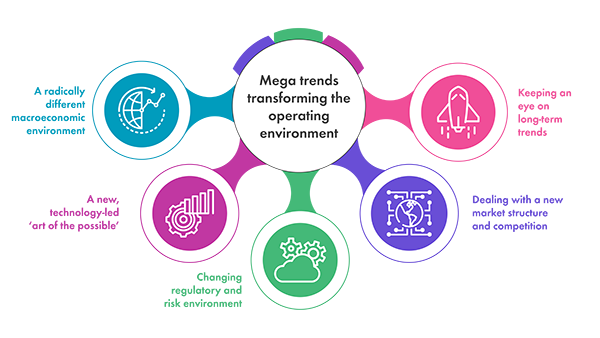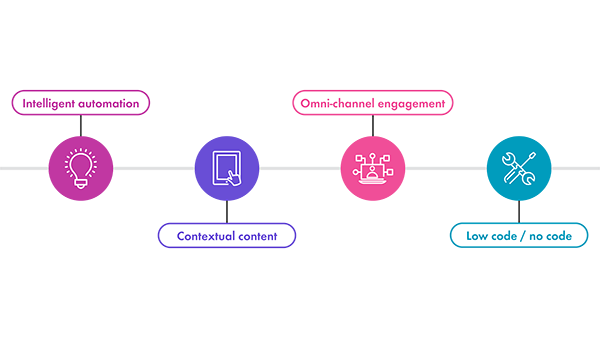Modernizing corporate banking

Just like the rest of the business world, corporate banking continues to evolve at a rapid pace as it strives to adapt to changing client needs and manage various external pressures.
We pulled together thoughts from industry experts, as they discussed some of the key challenges and drivers shaping the evolution of corporate banking, highlighted the role of next-generation technologies, and explored strategies for financial institutions (FIs) to modernize successfully.
Emerging trends influencing the operating environment
Enrico Muti and Markus Röhrig, partners in McKinsey’s European Corporate Banking Practice, see five key emerging shifts that are influencing the corporate banking environment, quoting McKinsey’s latest publication “Five big shift shaping a new world for corporate and investment banks”.

A radically different macroeconomic environment. As a result of ongoing economic and geopolitical issues, corporate banks need to cope with a few major changes. Firstly, higher interest rates have changed lending dynamics – increasing profitability on the front book but creating pressure on some areas of the back book. Secondly, there is a renewed focus on commercial deposits. With liquidity management now firmly front and centre, banks are focusing on optimizing their pricing and product offerings to optimize deposits, as Enrico says “[…] deeply leveraging the power of advanced analytical models to predict liquidity evolution and re-engage the frontline thanks to these augmented insights”.
A new, technology-led ‘art of the possible’. Technology continues to fuel major advances across the industry. “Digital and analytical enablement is strengthening the front office, with generative AI offering the potential to revolutionize frontline effectiveness and efficiency. “Much of the corporate banking journey could be augmented through gen AI, which need to be implemented at scale to achieve the desired impact,” Enrico suggests.
Changing regulatory and risk environment. New capital and liquidity requirements, as required for example by Basel IV, are expected to be a potential driver of change for the strategies of certain corporate banking products.
“Corporate banks must continue to manage evolving expectations related to treasury and liquidity risk, and deliver on the higher counterparty credit risk requirements, among other things. Emerging risks related to GenAI require careful consideration, and climate-related risks and stress testing continue to require increased attention,” says Markus.
Dealing with a new market structure and competition. Enrico suggests that the shift to private credit is considerable, with the amount of business no longer intermediated by banks continuing to grow at pace: “These dynamics provide opportunities for banks to reconsider their lending strategies, collaborating with investors and new players. Indeed, we’re seeing an increasing number of banks announcing partnerships and other initiatives to capture this opportunity.”
Keeping an eye on long-term trends. Various longer-term trends, such as the climate transition and sustainable financing, are creating both challenges and opportunities for FIs. “Given the unprecedented amount of capital required to achieve the net zero transition, banks are now increasingly seeking out investment opportunities in the decarbonization space,” Markus stresses. “This includes acting as a strategic partner and advisor for corporate clients on the decarbonization journey and building an ecosystem of partners to capture new business.”
Modernization priorities for corporate banks
Given this changing environment, Microsoft’s Industry Digital Advisor, Tiffany Carpenter, suggests several emerging priorities that corporate banks may want to focus on to remain competitive in an evolving world.
“Firstly, given the heightened focus on digitization in our everyday lives, it’s imperative that FIs deliver a seamless, completely digital onboarding experience for corporate clients. The onboarding experience is essential for establishing a successful, long-term client relationship, so it needs to be smooth and efficient. Offering hassle-free KYC processes with minimal data entry is key, which means digital interfaces should be integrated with automated back-office operations – which are often left behind while organizations focus on the front end,” Tiffany explains.
“Indeed, offering a consistent experience across channels, products and services is a top priority for many FIs. As such, we’re also seeing exponential growth in invisible finance, with banks embedding their services directly into clients’ systems and processes.”
Tiffany suggests that banks could help their clients access financial solutions more quickly if they can simplify and transform their complex, often paper-driven, lending operations – primarily by automating manual processes.
“Similarly, while trade finance is likely to continue to be very paper-based in the short-term, FIs may want to think about modernizing their distributed trade finance operations, in part through automation and also by integrating various aspects of the process.”
Finally, while banks are collecting and using vast amount of data, Tiffany says it’s often siloed and scattered across the organization: “Banks must integrate compliance, regulatory and ESG requirements into their operational fabric. They also need to turn their reporting data into actionable insights – from supporting clients with recommendations on how they can improve their ESG scores, to using their data to drive sustainable change within the economy.”

The role of next-generation technologies
Next generation technologies – particularly artificial intelligence, GenAI, machine and deep learning, natural language processing and computer vision – are playing an integral role in the modernization of corporate banking. Tiffany provides four examples of how FIs can use next-generation technologies to ensure they don’t get left behind.
Intelligent automation. While robotic process automation (RPA) has helped automate many processes, combining RPA with AI allows FIs to automate more complete end-to end business processes, thereby enabling real-time automated decisioning, increasing efficiencies and reducing costs.
Contextual content. “Offering the ability to automatically capture, extract, process and transform unstructured data from business documents, emails, PDFs and images can provide end-to-end automation and decisioning for document-centric processes,” says Tiffany.
Omni-channel engagement. More and more customer engagement platforms offering a unified and consistent banking experience are appearing across the industry. “When an FI combines these customer engagement platforms with AI, intelligent automation and contextual content services, it’s able to create a much more seamless experience for its customers,” Tiffany explains.
Low code/no code. Last but not least, GenAI and other low-code / no-code solutions are accelerating the pace of innovation across the industry.
Success factors driving modernization and growth
Being able to rapidly access, embrace and adapt to the latest technology to modernize and drive growth is clearly key, but what should FIs do to ensure success?
Focus on the bigger picture
Tiffany suggests that FIs should focus first on how technology can help overcome business challenges –rather than on the technology itself: “To be successful, banks must view technology as an enabler, leveraging it to drive transformation, innovation and competitiveness in the market.”
Similarly, Josh Scriven, Vice President of Technology Services at Neudesic, says: "Before banks introduce new technologies, they need to consider their data readiness. Do they have access to good quality data to ensure they can get the best out of next-generation technologies?”
Integrate with the wider ecosystem
To remain agile and responsive to evolving customer needs and market changes, it’s essential for banks to go beyond merely updating legacy systems. They must integrate with the wider ecosystem to ensure they are ready and well-prepared for future developments, and to integrate new solutions quickly This requires a different approach to implementing technology, one which relies on an ecosystem play rather than simply point-to-point integrations.
“It’s not just about modernizing your infrastructure. It’s also essential to have an agile operating model that allows your organization to respond to opportunities and mitigate risks quickly. Having the right expertise to ensure you can extract maximum value from a modernization or transformation program is also key,” adds Marc Bandel, Cloud Solutions Specialist at Microsoft.
In addition, banks should think about how they can modernize specific components to drive efficiencies. “As part of this, it’s important to minimize rework and waste by reusing as many components as possible – not everything in a bank’s legacy system is bad, some things will be future-proofed,” says Sudip Gupta, one of IBM’s Banking Industry leaders.
Collaborate
As is often the case, collaboration is key. The complexity of modernization in an evolving ecosystem, more specifically meaning that everyone can benefit from working together. Instead of re-inventing the wheel and trying to tackle challenges individually, organizations should rather collaborate to achieve better results.
Josh also believes that there’s an element of shared responsibility, and an opportunity for fintechs and banks to ‘meet in the middle’: “Collaboration opens the ability to share APIs and data, and accelerate learning. There’s also considerable opportunity to develop a standardized API library and industry frameworks to enable an integrated ecosystem and services with the potential to uplift the whole industry.”
Ensure scalability
Time-to-market and time-to-scale are crucial in terms of unlocking the business opportunities that come with modernization. Scalability to meet demand is no longer just about putting increased numbers of people in place, it’s about ensuring that your systems are modernized, agile and able to handle those demands.
Three strategies for success
McKinsey suggests a three-step approach to help them navigate and capitalize on the evolving operating environment.
- Secure near-term resilience to new risks. FIs should ensure they have the right foundations in place to build resilience and tackle risks. Enrico explains: “This includes addressing the assets most likely to be challenged, driving near-term efficiencies and operational leverage, improving capital accuracy and optimization, and addressing any risk and regulatory gaps.”
- Invest in enabling capabilities. “It’s crucial to have the right capabilities, technical know-how, and talent pool suitable for the next 10-15 years. Building a ‘fit for purpose’ technology organization requires investment today to be ready for tomorrow,” says Markus.
- Find your ‘North Star’. Finally, given the variety of uncertain elements impacting the new operating environment, Enrico and Markus underline the importance of doubling down on at-scale pockets of excellence, leading with a well-crafted value creation narrative, and getting alignment behind a clear organizational guiding ‘North Star’.


